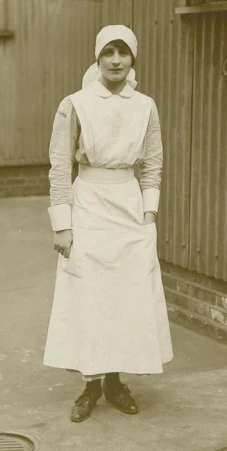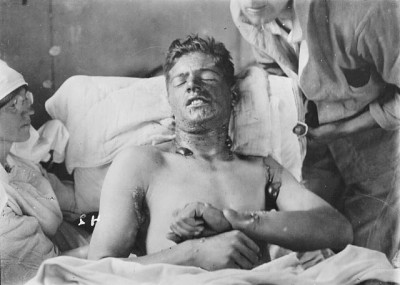
Vera Brittain when a VAD nurse. (Literary Executors for the Vera Brittain Estate, 1970 &The Vera Brittain Fonds, McMaster University Library)
From early August 1917 until the end of April 1918 Vera Brittain served as a Voluntary Aid Detachment nurse at No 24 General Hospital, Étaples. She wrote about this experience in her acclaimed and powerful memoir Testament of Youth in the chapter entitled ‘Between the Sandhills and the Sea’. Étaples is a fishing port fifteen miles from Boulogne, and just to the north the British established a large infantry training camp and a complex of nine major hospitals, almost entirely comprised of huts and tents.

A plan of the Étaples Base Camp and hospital complex with No 24 General Hospital marked. (http://www.oucs.ox.ac.uk/ww1lit/gwa/document/9127/4558)

The area of the Étaples Base Camp and hospital complex today. The area occupied by No 24 General Hospital is now covered by housing.
She was first assigned to the ward for acute German cases and then treated mustard gas cases suffering severe skin blistering and temporary or sometimes permanent blindness.

A Canadian victim of mustard gas at No.7 Canadian General Hospital, Etaples, c. 1917 (Library and Archives Canada/ Wikimedia).
No 24 General Hospital was not in the ‘front line’, as the fighting was never less than fifty miles from Étaples, nor was it a Casualty Clearing Station but it was bombed several times in 1918. The hospitals were hit by bombs because they were built alongside the Boulogne to Paris railway and were adjacent to the major complex of training camps, both of which were targeted. Vera experienced over a month of night-time air raids which left her exhausted and ‘more frightened than I had ever been in my life’. She left Étaples before the worst bombing raids of May, June and August 1918 when patients and nurses were killed in No 24 General and neighbouring hospitals.

A First Aid Nursing Yeomanry driver with an unexploded German aerial bomb at a British hospital in Calais, 1917.
Where and how did Edward Brittain die?
Protection against Mustard Gas
‘Anon.’ no longer: the author of the ‘Menin Gate’ poem revealed


Read this with great interest as my Grandfather was at Etaples before being sent back to a convalescent hospital in Canterbury. Tried looking for the site when we were in France the last time, but ferry times and industrial estates got the better of us. Wish we had you map then!!
There’s detail about Vera Brittain’s hospital in Mark Bostridge’s Vera Brittain and the First World War. It includes a gazetteer which says that the 24 General was in the Avenue du Pave.
Thank you Mary, the road along the northern boundary of the hospital site is the Avenue du Blanc Pavé.
Uniformed woman with unexploded aerial bomb is not a Red Cross nurse but a member of the First Aid Nursing Yeomanry (FANY). Not nurses, not First Aiders, but (in the Great war at any rate) military drivers.
Thank you Alisa, I’ve amended the text with the photo.
Thanks for this info on VB Simon
Re the FANY in the photo with the unexploded bomb, it shows Sheila Mason, not Violet O’Neill Power. It was taken after a German raid on Calais in the autumn of 1917. Mason was a driver with the British Calais Convoy. This was their barracks in Calais, not a hospital. From the fany(prvc) archives.
Lynette Beardwood
Dear Lynette, Thank you very much for letting me know and given your work on the FANY in the Great War I have no doubt about your knowledge on the subject. I had identified her as Violet O’Neill Power from a caption to this same photo in a PDF on the fany.org.uk website but the document has now been removed! I had also found Violet’s passport, I think on the same website and thought there was some resemblance but that is now also gone, although the photo is here https://livesofthefirstworldwar.org/lifestory/5153419. I’d love to know more about the identification so I can correct it. I bought the postcard photograph about thirty years ago but it was only in the past few years that I discovered the supposed identification as Violet. Regards, Simon
Hello Simon, the information is correct, we have the photo in our archives with a handwritten caption.where did you buy the postcard?
Thank you Lynette. It’s almost exactly a year since we were in email correspondence about the photo of Sheila Mason. As to where I bought the card all those years ago, I couldn’t tell you but it might have been from a postcard dealer when I used to go to big postcard fairs in London. Regards, Simon
Hi Simon, glad you are still interested. I have recently got some photos of VADs in France.
Here is the same photograph in the collection of the Imperial War Museum. https://www.iwm.org.uk/collections/item/object/205299660